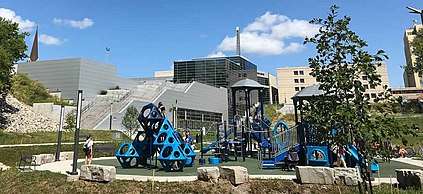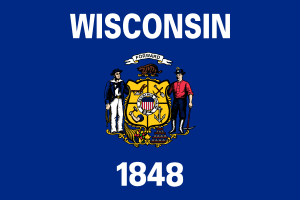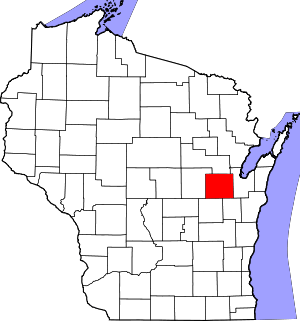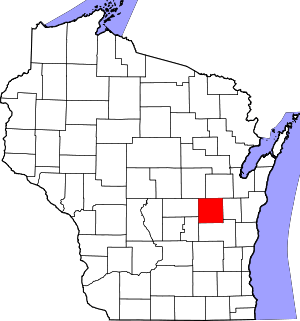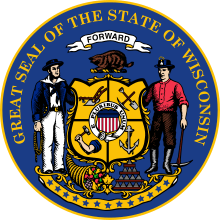Appleton, Wisconsin
Appleton is a city in Outagamie (mostly), Calumet, and Winnebago counties in the U.S. state of Wisconsin. One of the Fox Cities, it is situated on the Fox River, 30 miles (48 km) southwest of Green Bay and 100 miles (160 km) north of Milwaukee. Appleton is the county seat of Outagamie County. The population was 72,623 at the 2010 census. Of this figure, 60,045 resided in Outagamie County, 11,088 in Calumet County, and 1,490 in Winnebago County. Appleton is the principal city of the Appleton, Wisconsin Metropolitan Statistical Area, which is included in the Appleton-Oshkosh-Neenah Combined Statistical Area, the third largest in the state behind Milwaukee and Madison.
Appleton, Wisconsin | |
|---|---|
 Clockwise from top: Downtown Appleton Skyline, Main Hall (Lawrence University), Neuroscience Group Field at Fox Cities Stadium, Fox River Mall, Houdini Plaza | |
 Location of Appleton in Outagamie, Calumet, and Winnebago Counties, Wisconsin | |
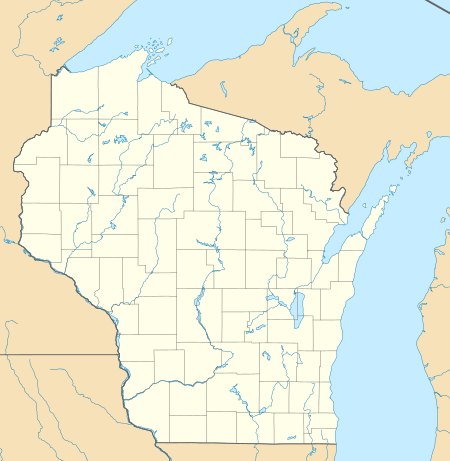 Appleton Location in Wisconsin  Appleton Appleton (the United States)  Appleton Appleton (North America) | |
| Coordinates: 44°16′N 88°24′W | |
| Country | United States |
| State | Wisconsin |
| Counties | Outagamie, Calumet, Winnebago |
| Surrounding Towns | Grand Chute, Little Chute, Menasha, Kimberly |
| Settled | 1835 |
| Incorporated | May 2, 1857 |
| Named for | Samuel Appleton |
| Government | |
| • Type | Mayor-Council |
| • Mayor | Jake Woodford[1] |
| Area | |
| • City | 25.22 sq mi (65.31 km2) |
| • Land | 24.73 sq mi (64.06 km2) |
| • Water | 0.48 sq mi (1.25 km2) 1.97% |
| Elevation | 790 ft (240 m) |
| Population | |
| • City | 72,623 |
| • Estimate (2019)[4] | 74,098 |
| • Density | 3,013.10/sq mi (1,163.36/km2) |
| • Urban | 216,154 (US: 165th) |
| • Metro | 236,126 (US: 194th) |
| • Metro density | 2,160/sq mi (834/km2) |
| Demonym(s) | Appletonians[5] |
| Time zone | UTC−06:00 (CST) |
| • Summer (DST) | UTC−05:00 (CDT) |
| ZIP Code | 54911, 54912, 54913, 54914, 54915, 54919 |
| Area code(s) | 920 |
| FIPS code | 55-02375[6] |
| GNIS feature ID | 1560914[7] |
| Major airport | Appleton International Airport (ATW) |
| Major Routes | |
| Website | www |
Appleton serves as the heart of the Fox River Valley, and is home to the Fox Cities Exhibition Center, Fox Cities Performing Arts Center, Fox River Mall, Neuroscience Group Field at Fox Cities Stadium, Appleton International Airport, and the Valley's two major hospitals: St. Elizabeth Hospital and ThedaCare Regional Medical Center–Appleton (better known as "Appleton Medical Center"). It also hosts many regional events such as its Flag Day parade, Memorial Day parade, Christmas parade, Octoberfest, Mile of Music, and others.
History
Pre-settlement
The territory where Appleton is today was traditionally occupied by the Ho-Chunk and the Menominee. The Menominee Nation ceded the territory to the United States in the Treaty of the Cedars in 1836, with Chief Oshkosh representing the Menominee. The treaty came at the end of several years of negotiations between the Menominee, the Ho-Chunk and the federal government about how to accommodate the Oneida, Stockbridge-Munsee, and Brothertown peoples who were removed from New York to Wisconsin.[8] The Ho-Chunk never ratified the final treaty as only the Menominee ceded land.[9] In the Menominee language, Appleton is known as Ahkōnemeh, or "watches for them place".[10]
The first European settlers in Appleton were fur traders seeking to do business with Fox River Valley Native Americans. Hippolyte Grignon built the White Heron in 1835 to house his family and serve as an inn and trading post.[11]
Town
Appleton was settled in 1847 and incorporated as a village in 1853. John F. Johnston was the first resident and village president. Lawrence University, also founded in 1847, was backed financially by Amos A. Lawrence and originally known as the Lawrence Institute. Samuel Appleton, Lawrence's father-in-law from New England who never visited Wisconsin, donated $10,000 to the newly founded college library, and the town took his name in appreciation.[12][13][14]
The community was incorporated as a city on March 2, 1857,[15] with Amos Storey as its first mayor. Early in the 20th century, it adopted the commission form of government. In 1890, 11,869 people lived in Appleton; in 1900, there were 15,085; in 1910, 16,773; in 1920, 19,571; and in 1940, 28,436.

The paper industry, beginning with the building of the first paper mill in the city in 1853, has been at the forefront of the development of Appleton. In order to provide electricity to the paper industry, the nation's first hydro-electric central station, the Vulcan Street Plant on the Fox River, began operation on September 30, 1882. The power plant also powered the Hearthstone House, the first residence in the world powered by a centrally located hydroelectric station using the Edison system.[17]
Shortly thereafter, in August 1886, Appleton was the site for another national first, the operation of a commercially successful electric streetcar company. Electric lights replaced gas lamps on College Avenue in 1912. Appleton also had the first telephone in Wisconsin, and the first incandescent light in any city outside of the East Coast.[18]
Appleton's tallest building, the 222 Building was built in 1952. The Valley Fair Shopping Center, built in 1954, laid claim to being the first enclosed shopping mall in the United States, although this claim is disputed by other malls. In 2007 most of the structure was demolished, leaving only its east wing and a movie theater. A Pick 'n Save Food Center now stands in its place.
From approximately 1930–1970, Appleton was a sundown town: black people were not allowed to stay overnight.[19] There was no official city ordinance, only an unwritten law enforced informally, such as by police strongly encouraging black people to leave town after dark.[20] In 1936, the Institute of Paper Chemistry tried to hire the famous African-American chemist Percy Julian, but could not figure out how to get around the sundown law; Julian was hired by Glidden in Chicago instead.[21][22] A partial exception was made for opera singer Marian Anderson when she sang at Lawrence University in 1941: she was allowed to stay overnight in the Conway Hotel but was not allowed to eat dinner in public.[23]
Geography
Appleton is located at 44°16′N 88°24′W (44.278819, -88.392625).[24] According to the United States Census Bureau, the city has a total area of 24.82 square miles (64.28 km2), of which, 24.33 square miles (63.01 km2) is land and 0.49 square miles (1.27 km2) is water.[25]
Climate
Appleton has a humid continental climate[26] typical of Wisconsin. Summers are warm to hot and winters are rather cold in comparison. Precipitation is relatively moderate compared to other areas close to the Great Lakes, which means lesser snowfall in winter than in many other cold areas.[27]
A dew point of 90 °F (32 °C) was observed at Appleton at 5 p.m. on July 13, 1995. This is tied for the second highest dew point ever observed in the United States.
| Climate data for Appleton | |||||||||||||
|---|---|---|---|---|---|---|---|---|---|---|---|---|---|
| Month | Jan | Feb | Mar | Apr | May | Jun | Jul | Aug | Sep | Oct | Nov | Dec | Year |
| Record high °F (°C) | 55 (13) |
59 (15) |
81 (27) |
89 (32) |
94 (34) |
101 (38) |
107 (42) |
103 (39) |
101 (38) |
89 (32) |
75 (24) |
61 (16) |
107 (42) |
| Average high °F (°C) | 24.7 (−4.1) |
28.1 (−2.2) |
39.1 (3.9) |
54.0 (12.2) |
67.0 (19.4) |
76.7 (24.8) |
81.9 (27.7) |
79.5 (26.4) |
70.9 (21.6) |
58.4 (14.7) |
42.6 (5.9) |
29.1 (−1.6) |
54.3 (12.4) |
| Average low °F (°C) | 8.7 (−12.9) |
11.0 (−11.7) |
22.2 (−5.4) |
34.6 (1.4) |
45.8 (7.7) |
55.9 (13.3) |
61.3 (16.3) |
59.3 (15.2) |
51.3 (10.7) |
40.3 (4.6) |
28.0 (−2.2) |
14.8 (−9.6) |
36.1 (2.3) |
| Record low °F (°C) | −30 (−34) |
−32 (−36) |
−21 (−29) |
7 (−14) |
23 (−5) |
34 (1) |
41 (5) |
35 (2) |
25 (−4) |
15 (−9) |
−7 (−22) |
−23 (−31) |
−32 (−36) |
| Average rainfall inches (mm) | 1.3 (33) |
1.1 (28) |
1.9 (48) |
2.7 (69) |
3.4 (86) |
3.8 (97) |
3.4 (86) |
3.2 (81) |
3.4 (86) |
2.2 (56) |
2.0 (51) |
1.4 (36) |
30 (760) |
| Source: Weatherbase[27] | |||||||||||||
Demographics
| Historical population | |||
|---|---|---|---|
| Census | Pop. | %± | |
| 1860 | 2,345 | — | |
| 1870 | 4,518 | 92.7% | |
| 1880 | 8,005 | 77.2% | |
| 1890 | 11,869 | 48.3% | |
| 1900 | 15,085 | 27.1% | |
| 1910 | 16,773 | 11.2% | |
| 1920 | 19,561 | 16.6% | |
| 1930 | 25,267 | 29.2% | |
| 1940 | 28,436 | 12.5% | |
| 1950 | 34,010 | 19.6% | |
| 1960 | 48,411 | 42.3% | |
| 1970 | 56,377 | 16.5% | |
| 1980 | 58,913 | 4.5% | |
| 1990 | 65,695 | 11.5% | |
| 2000 | 70,087 | 6.7% | |
| 2010 | 72,623 | 3.6% | |
| Est. 2019 | 74,098 | [4] | 2.0% |
| U.S. Decennial Census[28] | |||
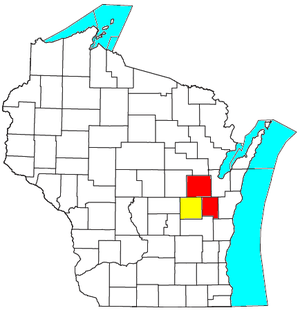
Appleton is the principal city of the Appleton–Oshkosh–Neenah CSA, a Combined Statistical Area which includes the Appleton (Calumet and Outagamie counties) and Oshkosh–Neenah (Winnebago County) metropolitan areas, which had a combined population of 367,365 at the 2010 census.[6]
2010 census
As of the census[3] of 2010, there were 72,623 people, 28,874 households, and 18,271 families residing in the city. The population density was 2,984.9 inhabitants per square mile (1,152.5/km2). There were 30,348 housing units at an average density of 1,247.3 per square mile (481.6/km2). The racial makeup of the city was 87.5% White, 1.7% African American, 0.7% Native American, 5.9% Asian, 2.2% from other races, and 2.0% from two or more races. Hispanic or Latino of any race were 5.0% of the population.
There were 28,874 households, of which 33.0% had children under the age of 18 living with them, 48.7% were married couples living together, 10.5% had a female householder with no husband present, 4.1% had a male householder with no wife present, and 36.7% were non-families. 29.5% of all households were made up of individuals, and 9% had someone living alone who was 65 years of age or older. The average household size was 2.43 and the average family size was 3.04.
The median age in the city was 35.3 years. 25% of residents were under the age of 18; 10.1% were between the ages of 18 and 24; 27.7% were from 25 to 44; 26.1% were from 45 to 64; and 11.3% were 65 years of age or older. The gender makeup of the city was 49.5% male and 50.5% female.
2000 census
As of the census[6] of 2000, there were 70,087 people, 26,864 households, and 17,676 families residing in the city. The population density was 3,355.9 per square mile (1,295.7/km2). There were 27,736 housing units at an average density of 1,328.0 per square mile (512.7/km2). The racial makeup of the city was 91.48% White; 0.99% African American; 0.57% Native American; 4.61% Asian; 0.03% Pacific Islander; 1.05% from other races, and 1.27% from two or more races. Hispanic or Latino of any race were 2.53% of the population.
There were 26,864 households, out of which 35.0% had children under the age of 18 living with them, 53.9% were married couples living together, 8.7% had a female householder with no husband present, and 34.2% were non-families. 27.6% of all households were made up of individuals, and 9.1% had someone living alone who was 65 years of age or older. The average household size was 2.52 and the average family size was 3.13.
In the city, the population was spread out, with 27.4% under the age of 18; 9.7% from 18 to 24; 31.8% from 25 to 44; 19.7% from 45 to 64, and 11.3% who were 65 years of age or older. The median age was 34 years. For every 100 females, there were 96.7 males. For every 100 females age 18 and over, there were 93.7 males.
The median income for a household in the city was $39,285, and the median income for a family was $44,097. Males had a median income of $36,459 versus $22,890 for females. The per capita income for the city was $17,478. About 7.3% of families and 9.5% of the population were below the poverty line, including 7.1% of those under age 18 and 4.8% of those age 65 or over.
Crime
FBI crime statistics for 2009 list the crime rate (per 100,000 population) for Appleton as follows:[29]
| Crime | Appleton | Wisconsin | United States |
|---|---|---|---|
| Violent crime | 234.7 | 257.0 | 429.4 |
| Murder | 1.4 | 2.5 | 5.0 |
| Forcible rape | 29.9 | 19.6 | 28.7 |
| Robbery | 25.6 | 85.8 | 133.0 |
| Aggravated assault | 177.8 | 149.1 | 262.8 |
| Property crime | 2,680.2 | 2,608.2 | 3,036.1 |
| Burglary | 465.2 | 472.9 | 716.3 |
| Larceny-theft | 2,163.8 | 1,977.4 | 2,060.9 |
| Motor vehicle theft | 51.2 | 157.8 | 258.8 |
Government
Appleton is governed via the mayor-council system. The mayor appoints department heads, subject to council approval. The city attorney is elected every four years in a citywide vote. The council, known as the common council or city council, consists of 15 members, called alderpersons, all of whom are elected to two-year terms from individual districts.
The current mayor of Appleton, Jake Woodford, was elected in 2020 to his first four-year term. In April 1857, Appleton voters chose Amos Story as the city's first mayor. List of last ten mayors of Appleton:[30]
- John Goodland, Jr. 1924 - 1925
- Albert Rule 1926 - 1929
- John Goodland, Jr. 1930 - 1946
- Robert Roemer 1946 - 1958
- Clarence Mitchell 1958 - 1966
- George Buckley 1966 - 1972
- James Sutherland 1972 - 1980
- Dorothy Johnson 1980 - 1992
- Richard DeBroux 1992 - 1996
- Timothy Hanna 1996 – 2020
- Jake Woodford 2020 - present
Appleton is represented by Mike Gallagher (R) in the United States House of Representatives, and by Ron Johnson (R) and Tammy Baldwin (D) in the United States Senate. In the Wisconsin state legislature, Appleton is divided among four State Assembly Districts (3rd, 55th, 56th, 57th) and two State Senate Districts (1st, 19th). As of the 2018-2019 legislative session, the following representatives serve these districts:
- 3rd Assembly District: Ron Tusler (R - Harrison)
- 55th Assembly District: Mike Rohrkaste (R - Neenah)
- 56th Assembly District: David Murphy (R - Greenville)
- 57th Assembly District: Amanda Stuck (D - Appleton)
- 1st Senate District: André Jacque (R - DePere)
- 19th Senate District: Roger Roth (R - Appleton)
Transportation

The city owns Valley Transit, a network of bus lines serving the Fox Valley. There are also several taxi operators in the city. Valley Transit operates routes that generally begin service as early as 5:45 AM and run until as late as 10:40 PM Monday through Saturday. Frequencies are usually every hour and every half-hour on certain routes during peak morning and afternoon times on weekdays. There is no service on Sunday. Amtrak and Lamers offer intercity buses serving such locations as Green Bay, Madison, Oshkosh, Fond du Lac, Milwaukee, and Chicago.
Roads
| Interstate 41 Northbound routes to Green Bay. Southbound I-41 routes to Oshkosh, Fond du Lac, and Milwaukee. This is a full interstate grade freeway that runs on the north side of Appleton. It has 3 exits in Appleton (from South to North):
Hwy 47 Richmond St. (Exit 142), Hwy E Ballard Rd. (Exit 144) and Hwy 441 (Exit 145) | |
| US 10 Westbound goes to Waupaca and Stevens Point. US 10 Eastbound goes to Brillion and Manitowoc. This is mostly a freeway except along Oneida St. | |
| US 41 runs entirely concurrent with Interstate 41 through the city of Appleton. | |
| WIS 47 travels Northbound to Black Creek and Shawano, Wisconsin. Southbound, WIS 47 routes to Menasha. This is Richmond St., Memorial Dr., and Appleton Rd. | |
| WIS 96 travels west to Fremont and travels east to Little Chute and Kaukauna. This is Wisconsin Ave. | |
| WIS 125 travels between US 41 and WIS 47 on College Ave. College Ave. west of US 41 is Hwy CA and heads to Appleton International Airport. | |
| WIS 441 bypasses Appleton on the south and east sides as a freeway. Exits are at:
US 10 West/US 41, Racine St Menasha, Hwy AP Midway Rd., WIS 47 Appleton Rd., US 10 East Oneida St., Hwy KK Calumet St., Hwy CE College Ave., Hwy OO Northland Ave., US 41 |
Rail
Appleton is criss-crossed by the former main lines of the Chicago and North Western Railway (southwest-northeast) and the Milwaukee, Lake Shore and Western (roughly southeast-northwest, and now largely abandoned except for local service to area paper mills and other industries). A north-south branch of the former Wisconsin Central Railroad passes on the west side of the city. All rail service is now operated by Canadian National Railway. Appleton has no intercity passenger rail service, although studies are being undertaken on the feasibility of extending Amtrak rail service to the Fox Cities and Green Bay.
Airport
The Appleton International Airport (ATW) is located at the west end of College Avenue, two miles west of Interstate 41 and six miles west of downtown Appleton.
Education

Appleton is served by the Appleton Area School District, which has three high schools, four middle schools, seventeen elementary schools, and sixteen charter schools. The district's main public high schools are Appleton East, Appleton North, and Appleton West.
The Wisconsin Evangelical Lutheran Synod (WELS) has four Christian elementary schools in Appleton: Mount Olive Lutheran School (Pre-K-8),[31] Riverview Lutheran School (Pre-K-8),[32] St. Paul Lutheran School (Pre-K-8),[33] and St. Peter Lutheran School (Pre-K-8).[34]
Appleton has two parochial high schools: Roman Catholic Xavier High School and Fox Valley Lutheran High School. Appleton also has charter high schools, including: Fox Cities Leadership Academy, Renaissance Academy, Appleton Technical Academy, and Tesla Engineering.
Appleton is home to Lawrence University, a private liberal arts college, and Fox Valley Technical College. Globe University, Concordia University Wisconsin,[35] and Rasmussen College have branch campuses in the city. The University of Wisconsin–Fox Valley, a two-year campus of the University of Wisconsin System, is located in nearby Menasha.
The city and surrounding area are served by the Appleton Public Library, which was chartered by the city in 1897 and as of 2010 has a collection of over 600,000 items.[11]
Economy
Largest employers
As of 2018, the largest employers in the city were:[36]
| Rank | Employer | # of Employees | Percentage of total city employment |
|---|---|---|---|
| 1 | St. Elizabeth Hospital/Affinity Health | 5,172 | 13.2% |
| 2 | Thrivent Financial | 2,001 | 5.1% |
| 3 | Appleton Area School District | 1,873 | 4.8% |
| 4 | Miller Electric | 1,484 | 3.8% |
| 5 | Appleton Medical Center | 1,434 | 3.7% |
| 6 | Outagamie County | 1,250 | 3.2% |
| 7 | Appvion, Inc. | 1,000 | 2.6% |
| 8 | West Business Services | 1,000 | 2.6% |
| 9 | Valley Packaging Industries | 950 | 2.4% |
| 10 | Walmart | 685 | 1.8% |
Companies headquartered in Appleton
Health care
The city is served by two hospitals:
- ThedaCare Regional Medical Center-Appleton
- St. Elizabeth Hospital
Tourism
Appleton tourist attractions include the Hearthstone House, the four-story mansion that was the first house in US to be powered by hydroelectricity at its completion in 1881.[11] The History Museum at the Castle contains exhibits on Fox River Valley history, including a gallery showcasing Edna Ferber, a Harry Houdini exhibit, and other travelling exhibits. The Paper Discovery Center has historic paper-making machines on display and an exhibit on the history of paper. The Fox River Mall is the second-largest mall in Wisconsin. Other local malls include Northland Mall, and City Center Plaza.
In 2013, Houdini Plaza, on the corner of College Avenue and Appleton Street, was renovated. The project cost around $1.5 million with most of that paid by the city itself. The plaza, known as the 'front yard' of downtown Appleton holds roughly 55 events each year, including summer concerts and part of the downtown farmers market.[38]
There are numerous performing ensembles in Appleton which include the Appleton Boy Choir, Fox Valley Symphony Orchestra, Makaroff Youth Ballet, newVoices Choir, Vento Winds, MacDowell Male Chorus, and Christmas Stars.
Parks
The city of Appleton has 24 neighborhood parks and four community parks in its park system. The neighborhood parks range in size from two acres to 16 acres, while the community parks range in size from 25 acres to 139 acres.
Memorial Park is the largest of the community parks, covering 139 acres. The park's facilities include: seven baseball/softball fields, playground equipment, an indoor ice skating rink, a sledding hill, a picnic pavilion, a catch-and-release fishing pond, grills, and a warming shelter.[39] The park provides a firework display for the Appleton community during the 4th of July holiday.
City Park, established in 1882, is the oldest park in the Appleton park system. The Trout Museum of Art uses the park for its Art in the Park showcase. The show features over 200 artists that attract over 25,000 art enthusiasts annually.[40] Pierce Park is the site of weekly Appleton City Band concerts held during the summer, and of the annual Appleton Old Car Show and Swap Meet. Pierce Park and Telulah Park each feature a disc-golf course. Erb Park and Mead Park each feature a public aquatics facility. Jones Park is the site of the finish line for the Santa Scamper run held during the annual Appleton Christmas Parade, and features an outdoor hockey rink in the winter.[41]
Notable people
Points of interest
- The Trout Museum of Art
- Fox Cities Performing Arts Center
- Fox Cities Exhibition Center
- Fox River Mall
- Fox Valley Technical College
- Gardens of the Fox Cities
- Goodland Field
- Hearthstone Historic House Museum
- History Museum at the Castle
- J. B. Courtney Woolen Mills
- John Hart Whorton House
- Lawrence University
- St. Paul Evangelical Lutheran Church
- Temple Zion and School
- Zion Lutheran Church
- Neuroscience Group Field at Fox Cities Stadium, home of the Wisconsin Timber Rattlers (Minor League-Class A Midwest League)


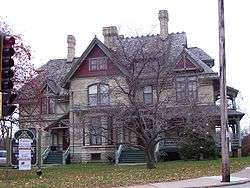
 Looking east at downtown Appleton
Looking east at downtown Appleton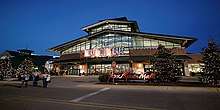
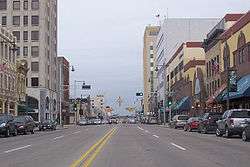 Looking west at downtown Appleton
Looking west at downtown Appleton- Looking east at downtown Appleton
- Looking west at downtown Appleton
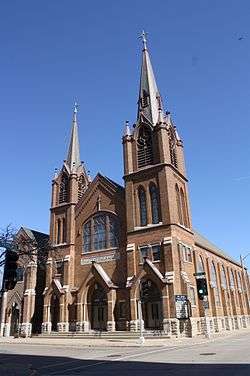
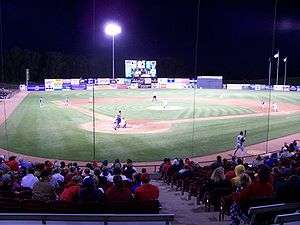

References
- "Mayor's Office | Appleton, WI". www.appleton.org. Retrieved April 22, 2020.
- "2018 U.S. Gazetteer Files". United States Census Bureau. Retrieved February 15, 2020.
- "U.S. Census website". United States Census Bureau. Retrieved November 18, 2012.
- "Population and Housing Unit Estimates". Retrieved May 21, 2020.
- "Noisey Would Like to Invite This Kid Who Dabbed Through Graduation to Be Our Intern". noisey. Vice. Retrieved July 7, 2017.
- "U.S. Census website". United States Census Bureau. Retrieved January 31, 2008.
- "US Board on Geographic Names". United States Geological Survey. October 25, 2007. Retrieved January 31, 2008.
- "Menominee Treaties and Treaty Rights". Indian Country Wisconsin. Retrieved October 5, 2018.
- "Ho-Chunk Treaties and Treaty Rights". Indian Country Wisconsin. Retrieved October 5, 2018.
- Hoffman, Mike. "Menominee Place Names in Wisconsin". The Menominee Clans Story. Retrieved October 5, 2018.
- "History of Appleton". Appleton Public Library. June 1, 2011. Retrieved December 28, 2011.
- Wineries of Wisconsin and Minnesota By Patricia Monaghan page 126
- Appleton.org | City of Appleton, Wisconsin Archived March 24, 2010, at the Wayback Machine
- "Profile for Appleton, Wisconsin". ePodunk. Retrieved June 20, 2010.
- Wisconsin (1857). Private and Local Laws Passed by the Legislature of Wisconsin in the Year 1857. Madison, Wisconsin: Calkins and Proudfit, Printers. pp. 243–283.
- Ted's Vintage Art. "Appleton, WI Historical Map - 1867". Ted's Vintage Art. Retrieved August 8, 2018.
- "Victorian Christmas", Beloit Daily News, December 15, 2005
- "Appleton [brief history]". Wisconsinhistory.org. Retrieved January 18, 2014.
- Loewen, James (2006). Sundown Towns: A Hidden Dimension of American Racism. New York: Touchstone. ISBN 0743294483.
- Peeples, Scott. "Appleton was indeed a 'Sundown Town'". Celebrate Diversity Fox Cities. Retrieved December 23, 2017.
- Bowden, Mary Ellen (1997). Chemical Achievers: The Human Face of the Chemical Sciences. Chemical Heritage Foundation. pp. 109–110. ISBN 0941901122.
- Anderson, Frank. Wicked Fox Cities: The Dark Side of the Valley. Arcadia Publishing.
- Anderson, Cheryl (October 18, 2014). "Lawrence to revisit 1941 concert of Marian Anderson". Post-Crescent. Appleton, Wisconsin. Retrieved December 23, 2017.
- "US Gazetteer files 2010 - Wisconsin place list". United States Census Bureau. Retrieved February 8, 2017.
- "US Gazetteer files 2010". United States Census Bureau. Archived from the original on January 24, 2012. Retrieved November 18, 2012.
- "Appleton, Wisconsin Climate Summary". Weatherbase. Retrieved February 6, 2015.
- "Appleton, Wisconsin Temperature Averages". Weatherbase. Retrieved February 6, 2015.
- "Census of Population and Housing". Census.gov. Retrieved June 4, 2015.
- "2009 Crime in the United States: Offenses Known to Law Enforcement". U.S. Department of Justice, Federal Bureau of Investigation. August 2011. Archived from the original on July 21, 2011. Retrieved August 7, 2011.
- http://content.mpl.org/cdm/search/collection/AMP/searchterm/Appleton%20Mayors/mode/exact/page/1
- "Mount Olive Lutheran School".
- "Riverview Lutheran School".
- "St. Paul Lutheran Ministries".
- "St. Peter Lutheran School".
- "Concordia's Locations". Visit Concordia. Concordia University. Archived from the original on April 16, 2016. Retrieved April 4, 2016.
- "Annual Financial Report - 2018". City of Appleton. December 31, 2018. Retrieved May 7, 2020.
- "SECURA sells its longtime Appleton building to Fleet Farm". Post-Crescent Media. Retrieved July 12, 2019.
- "Houdini Plaza Opens At Last!–The New Face of Downtown Appleton [Infographic]". Whoonew.com. July 10, 2013. Retrieved July 27, 2017.
- dminteractive.com. "Official Site of the City of Appleton | Appleton, WI". Appleton.org. Retrieved January 18, 2014.
- "Appleton, Wisconsin Parks and Places - City Park". Triviaasylum.com. August 2, 1996. Retrieved January 18, 2014.
- "Appleton Parks & Recreation". Appletonparkandrec.org. Retrieved January 18, 2014.
- Loewen, James (2006). Sundown Towns: A Hidden Dimension of American Racism. New York: Touchstone. ISBN 0743294483.
- Peeples, Scott. "Appleton was indeed a 'Sundown Town'". Celebrate Diversity Fox Cities. Retrieved December 23, 2017.
- Bowden, Mary Ellen (1997). Chemical Achievers: The Human Face of the Chemical Sciences. Chemical Heritage Foundation. pp. 109–110. ISBN 0941901122.
- Anderson, Frank. Wicked Fox Cities: The Dark Side of the Valley. Arcadia Publishing.
- Anderson, Cheryl (October 18, 2014). "Lawrence to revisit 1941 concert of Marian Anderson". Post-Crescent. Appleton, Wisconsin. Retrieved December 23, 2017.
Further reading
- Raney, William F. "Appleton". Wisconsin Magazine of History, vol. 33, no. 2 (December 1949):135-151.
External links
| Wikimedia Commons has media related to Appleton, Wisconsin. |
| Wikisource has the text of The New Student's Reference Work article "Appleton, Wis.". |

- City of Appleton

